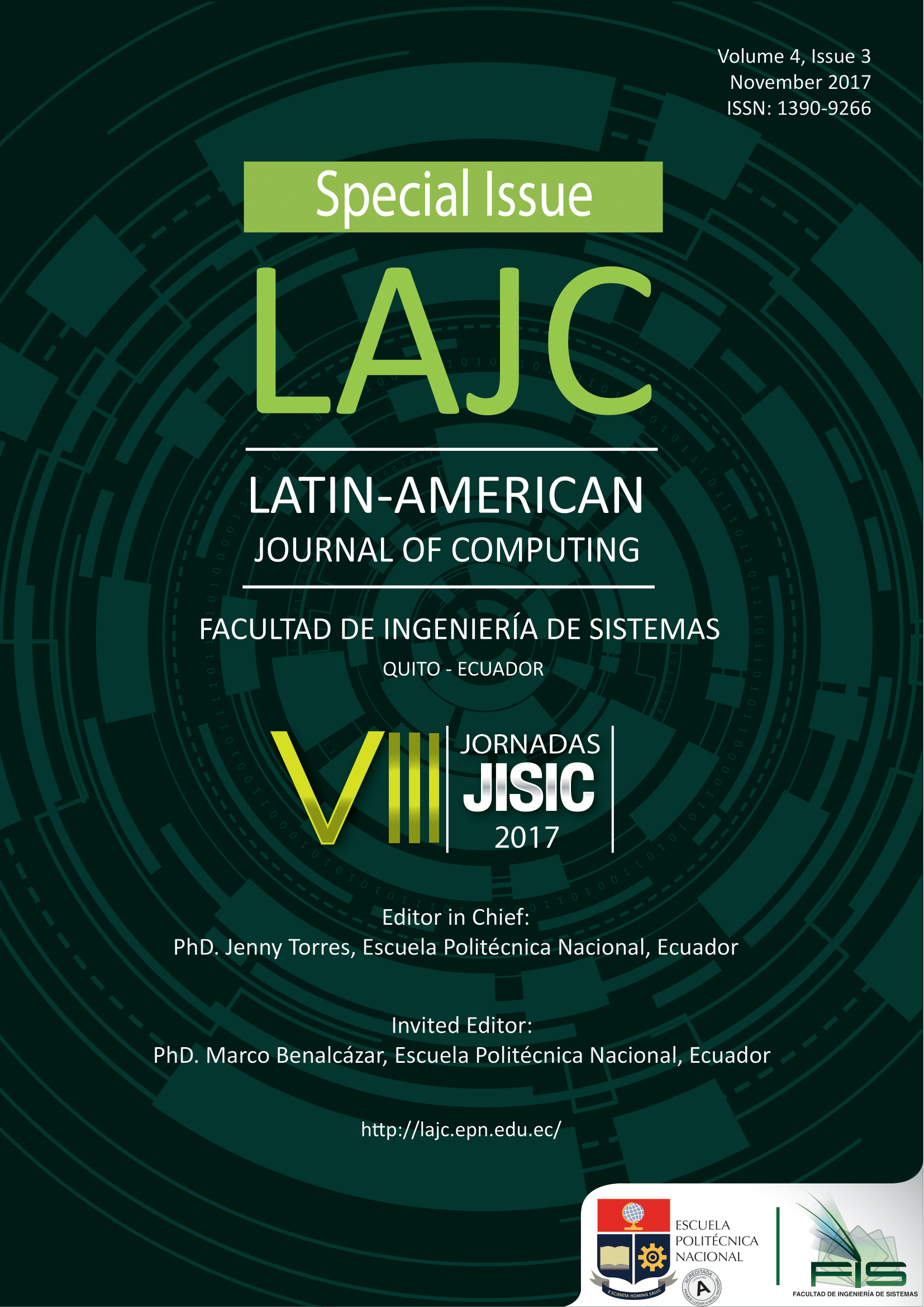Deep Learning as a predictive model to classify handwritten digits
Keywords:
Artificial Intelligence, Deep Learning, Handwritten digits, Otsu Method, Wavelet HaarAbstract
In this research work, the results of applying DeepLearning prediction models to identify the digit of an image,that contains a handwritten number of the MNIST database, arepresented. This set of dataset was acquired from the competitionof Kaggle: Digit Recognizer. The following process was applied:First, image preprocessing techniques were used, which focuson obtaining a pretty clear image and to reduce the size ofthe same, these objectives that are achieved with Otsu Method,transformed from Haar Wavelet and the Principal ComponentAnalysis (PCA), thus obtaining as a result, one set of new datasetto be evaluated. Second, the Deep Learning MxNET and H2omodels, which were executed in the statistical language R, wereapplied to these datasets obtained, this way, several predictionswere acquired. Finally, the best obtained predictions in theexperiment were sent to the Digit Recognizer competition, andthe results of this evaluation scored 99,129% of prediction.
Downloads
References
Kaggle,(2016).Digit Recognizer. Learn computer vision fundamentals with the famous MNIST data. Recuperado de: https://www.kaggle.com/c/digit-recognizer.
Kaggle, (2016). The Home of Data Science & Machine Lear-ning.Kaggle helps you learn, work, and play. Recuperado de:https://www.kaggle.com/.
Y. LeCun and C. Cortes and C. Burges, (2015).THE MNIST DATABASE of handwritten digits, Recuperado de: http://yann.lecun.com/exdb/mnist/.
L. Deng. (2012). The MNIST Database of Handwritten Digit Images forMachine Learning Research [Best of the Web].IEEE Signal Processing Magazine, 29, pp. 141142.
Y. LeCun, L. Bottou, Y. Bengio, y P. Haffner. (1998). Gradient-basedlearning applied to document recognition.IEEE, 86(11), pp. 2278-2324.
P. Y. Simard, D. Steinkraus, y J. C. Platt. (2003). Best Practices forConvolutional Neural Networks Applied to Visual Document Analysis.Document Analysis and Recognition.IEEE Computer Society Washing-ton, DC, USA, pp. 958.
L. Bottou, C. Cortes y J.S. Denke. (2002). Comparison of classifiermethods: a case study in handwritten digit recognition.IEEE. DOI:10.1109/ICPR.1994.576879.
E. Kussul, T. Baidyk. (2004). Improved method of handwritten digitrecognition tested on MNIST database. Image and Vision Computing,22(12), pp. 971-981.
J. Schmidhuber, (2015). Deep learning in neural networks: An overview. Neural Networks, 61, pp. 85 - 117.
CENPARMI,(2010). About CENPARMI. Centre for Pattern Recognition and Machine Intelligence. Recuperado de: http://www.concordia.ca/research/cenparmi.html.
CEDAR, (2008). About CEDAR. Handwriting Recognition. Recuperado de: https://www.cedar.buffalo.edu/Databases/JOCR/.
D. Ciregan, U. Meier, y J. Schmidhuber. (2012). Multi-column deep neural networks for image classification. IEEE,DOI:10.1109/CVPR.2012.6248110.
D. Ciregan, U. Meier, L. M. Gambardella y J. Schmidhuber. (2012).Deep Big Simple Neural Nets Excel on Handwritten Digit Recognition.IEEE, DOI: 10.1162/NECOa00052.
Ruiz-Vivanco, Omar. (2016).Análisis predictivo para clasificar dígitos escritos a mano utilizando la base de datos MNIST(tesis de maestría).Universidad del Pa ́ıs Vasco / Euskal Herriko Unibertsitatea (UPV/EHU),España.
Google Brain Team. (2016).TensorFlow is an Open Source SoftwareLibrary for Machine Intelligence. Recuperado de: https://www.tensorow.org/.
L. Jianzhuang, L. Wenqing y T. Yupeng. (2002). The Automatic Th-resholding of Gray-Level Pictures via Two-Dimensional Otsu Method.IEEE, DOI: 10.1109/CICCAS.1991.184351 .
L. Hui, C. Shi, A. Min-si y W. Yi-qi. (2008). Application of an Improved Genetic Algorithm in Image Segmentation. IEEE, DOI: 10.1109/CS-SE.2008.794.
J. Rodríguez.(2010).M ́etodootsu, Recuperado de: https://es.scribd.com/doc/45875911/Metodo.Otsu/.
Universidad Nacional de Quilmes. (2005).Segmentacio ́on por umbrali-zacio ́on - m ́etodo de otsu. Recuperado de: www.iaci.unq.edu.ar.
G. Jin-Sheng, y J. Wei-Sun. (2007). The Haar wavelets operational matrix of integration. International Journal of Systems Science, 27, pp.623-628.
J. Yang, D. Zhang y A.F. Frangi. (2004). Two-dimensional PCA: a new approach to appearance-based face representation and recognition. IEEE,DOI: 10.1109/TPAMI.2004.1261097.
M.Nunes.(2014).Package binhf, Recuperado de: https://cran.rproject.org/web/packages/binhf/binhf.pdf.
J. Johnson y A. Karpathy. (2016).Cs231n: Convolutional neural net-works for visual recognition. Recuperado de: http://cs231n.github.io/.
H2O Community. (2016). H2O Open Source Software Documen-tation.H2O and Sparkling Water Documentation. Recuperado de:http://docs.h2o.ai/h2o/latest-stable/index.html.
KDnuggets,(2016),Top 10 Deep Learning Projects on Github. Recuperado de: http://www.kdnuggets.com/2016/01/top-10-deeplearninggithub.html.
MXNetCommunity.(2016). MXNet Architecture. Flexible and Eficient Library for Deep Learning. Recuperado de: https://mxnet.readthedocs.io/en/latest/.
Downloads
Published
Issue
Section
License
Copyright Notice
Authors who publish this journal agree to the following terms:
- Authors retain copyright and grant the journal right of first publication with the work simultaneously licensed under a Creative Commons Attribution-Non-Commercial-Share-Alike 4.0 International 4.0 that allows others to share the work with an acknowledgement of the work's authorship and initial publication in this journal.
- Authors are able to enter into separate, additional contractual arrangements for the non-exclusive distribution of the journal's published version of the work (e.g., post it to an institutional repository or publish it in a book), with an acknowledgement of its initial publication in this journal.
- Authors are permitted and encouraged to post their work online (e.g., in institutional repositories or on their website) prior to and during the submission process, as it can lead to productive exchanges, as well as earlier and greater citation of published work.
Disclaimer
LAJC in no event shall be liable for any direct, indirect, incidental, punitive, or consequential copyright infringement claims related to articles that have been submitted for evaluation, or published in any issue of this journal. Find out more in our Disclaimer Notice.










